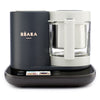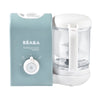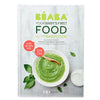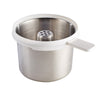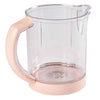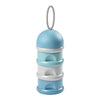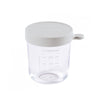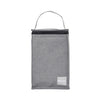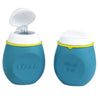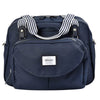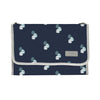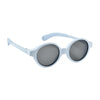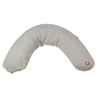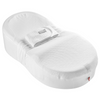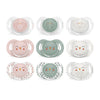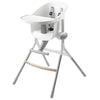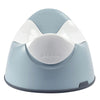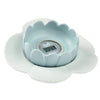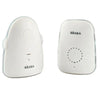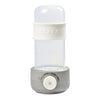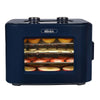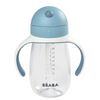FAQs
Cocoonababy by Red Castle
"My health visitor says that babies should lie on a firm surface. The nest seems soft so I’m not sure about using it"
A child should not be placed on a soft surface as his body will “sink” into it. But a flat, hard surface does not allow baby to lie in a cradled posture and to feel comfortable.
The Cocoonababy® is made of High Resilience foam which does not hold the baby's position in one fixed place. This foam is neither soft, nor flat, nor hard. It is made in such a way that the Cocoonababy®’s base is firm yet its top surface layer welcoming and gentle below baby's head (but in no case soft) and it has the capacity to resume its initial form. Its ergonomic design allows the child to develop while being firmly contained.
Baby does not risk sinking into it and the materials used for the cocoon allow him freedom and control of his movements. It is the adjustment of the wedge which makes it possible to give the baby the contained support he needs.
"I have been using the Cocoonababy® for my baby for the past two weeks and I find that the cocoon has become hollower than originally. Is that normal?"
That’s perfect. But the foam has not become more hollow rather the stretch netting fabric covering it offers less resistance and gives welcoming support to your baby.
"What is the purpose of the Tummy band?"
We actually created this tummy band to reassure parents worried that their baby could roll out of the cocoon. Although we advise you to stop using the Cocoonababy® well before baby knows how to turn over (e.g. stop using it for your baby as soon as he begins to try to change position in the cocoon), we decided that, to the extent that the tummy band does not alter the functionalities of the cocoon nor interfere with baby's movements, it would be a plus for the product. It has been validated by the medical profession and lastly, the slight pressure which it exerts on the baby’s tummy also reassures him.
"I read that a child can move in the cocoon but you say that he can’t get out of it"
When we say that a child can move in the Cocoonababy® we mean that he can turn his head to the right and to the left, move his arms which permits him to bring his hands up to his face and move his legs without being able to dig his heels in. However, he will not roll or turn over in the cocoon during his first months. His first sensory and motor experiences are facilitated by the cocoon. He would not be able to experience them within the same comfort were he to be lying on strictly flat on his back.
"You say that the Cocoonababy® can be used by baby day and night. Is that not too much?"
Because of its shape and materials, Cocoonababy® is the only product which allows day and night use whenever baby sleeps. The position taken by your child in the cocoon has been studied by health professionals to be the best one possible for his development. It is therefore important to place your child in the Cocoonababy® to sleep.
During the periods when he is awake, it is important to take your baby out of the Cocoonababy®, to play with him, hold them or put him in a baby carrier where he can also fall asleep in postures adjusted to his needs.
"I am worried that my baby may slip between the bars of his cot and the sides of the cocoon?"
No there is no risk of this happening as long as you follow the instructions for use closely and stop using the cocoon from the moment your child begins to try to change position in the cocoon.
During his first 3-4 months your child will not have sufficient motor development to allow him to get out of his Cocoonababy® by himself. If your baby has a tendency to bend forwards (when he has a sore tummy for example) go near him in his cocoon to check that he is not pressing down on his heels. The tummy band may also soothe him a little. The wedge must always be firmly placed against his buttocks.
"You seem to find it important that a baby can touch his face in Cocoonababy®. Why is this?"
In the womb a baby can touch his face and even suck his thumb. A newborn child lying on his back does not have the strength to bring his hands in front of his eyes or to his mouth. In the Cocoonababy®, he can immediately touch his face, suck his thumb and regroup his limbs towards his body. These experiences are essential to calm him and are already the first coordination movements which will help him in his future development.
"Some mothers say that there are other products on the market made in visco-elastic foam (foam with a memory) which are the same thing as the Cocoonababy®"
False. The Cocoonababy® is not made in visco-elastic foam (referred to as ‘memory foam’) but in a High Resilience foam which resumes its original shape and does not hold the baby in a fixed position.
The Cocoonababy® allows movement and helps the child to gain motor skills. Mattresses made of viscoelastic foam on the contrary, hold the child in the fixed position in which he was placed and are therefore to be avoided until he has acquired his own motor skills (around 4-5 months). Moreover, they do not offer him the necessary support (semi-foetal position and gentle incurve of the shoulders).
"There are baby bouncer style big cushions which seem to do the same as the nest Cocoonababy®?"
No, these products filled with small polystyrene beads (such as memory form foams) retain the child in his preferred position and counteract the benefits of the Cocoonababy®. When the baby moves, the bouncer’s fabric offers neither the resistance nor the flexibility required for baby's muscle tone.
"I think my nursing pillow could be used just as well for my baby during the first months. What is your opinon?"
No. Such products (like memory foam products) retain the child in the position he prefers and run counter to the benefits of the Cocoonababy® and when the baby moves such products offer neither the resistance nor the flexibility necessary for baby's muscle tone.
The shape and materials used for the Cocoonababy® are the result of several years of careful observation in the medical field and make the Cocoonababy® irreplaceable.
"Can the Cocoonababy be placed in a carrycot?"
No because a carrycot is not deep enough. The sides of the cot should be at least 50cms higher than the top of the cocoon (in line with the safety regulations and bedding standard).
Placed in a cot, with the cot base in the lowest position, the depth with the cot mattress in the cot must be more than 50cm. This is because in the Cocoonababy® the child will be higher than when lying on a flat mattress. The depth is required for baby’s safety in order to prevent him from reaching up and holding onto the top of the cot’s bars when a few months old. For this reason, the Cocoonababy® must not be used in a Moses basket, a rocking cradle, or in a stroller Carrycot.
"Can we use baby sleeping bags with the Cocoonababy® if not, how can I cover baby in the Cocoonababy®?"
A baby sleeping bag is not suitable for use in the cocoon. This accessory was created for babies sleeping on a strictly flat back. It adds an extra thickness between the baby and the cocoon and limits the motricity of his lower limbs thus providing limited comfort, (such as an adult sleeping in a sleeping bag).
To cover baby in the Cocoonababy® Red Castle suggests the Cocoonacover™ (blanket with a central opening which fits the shape of the Cocoonababy®.) The Cocoonacover™ allows you to cover your baby serenely and safely, it will not be able to rise up to baby’s face and can be chosen, according to the temperature of the room, in a lightweight or quilted version.
Whether covering baby in the Cocoonababy® or in a baby cot, traditional / classic baby blankets are not recommended before 10 months.
The Babynomade® blanket covers baby's arms and is for outdoor use only. It is not to be used to cover baby when he sleeps indoors, whether in his cot or in a Cocoonababy®.
"My baby seems quite warm in the Cocoonababy® cocoon"
In the Cocoonababy® cocoon, your baby will be warmer than lying on a traditional flat mattress. Take this into account and do not overdress baby. The Cocoonacover™ has been specifically designed for this purpose. Check baby's temperature by placing your fingers on the nape of his neck: if baby appears warm, uncover him. The ideal temperature for the baby's bedroom is 19°-20°.
"If I place my baby in the cocoon during the daytime when he is awake, how can I distract him?"
You can place him for example on a playmat with a play arch or in the Cocoonababy® in his cot with a toy mobile but make sure that the toys are always at his feet level and not directly above his head.
Contrary to current practice, it is very important that the gaze of a child lying down be drawn towards his feet (rather than above him) in order that he adopt a cradled rather than a hyper extended position. Lying in the cocoon baby will also be able to follow the movements of family members and will be happy to participate in the daily life around him.
We remind you that the cocoon can be used by baby for sleeping as well as during short periods when he is awake and calm (when he has just eaten for example and you want to place him down comfortably out of your arms).
Stay close to him and play with him, sing to him or interact with him, speak to him and show him objects. You can also install baby in a slightly off-centered dorsal position with his weight more on his left or his right buttock. To do so adjust the wedge at a slight angle to hold the angle of his pelvis. Of course, the most suitable place is in your arms as well as a baby wrap carrier.
Click here for Cocoonababy Nest Instruction Manual


